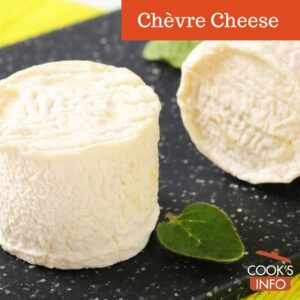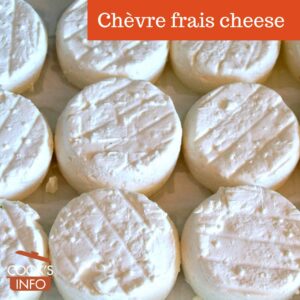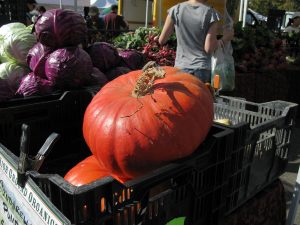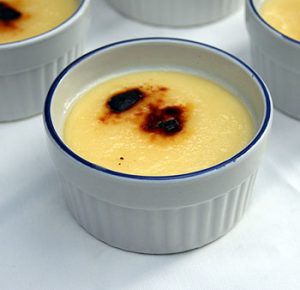A Charentais devil is a low, flat unglazed earthenware pot with a small opening at the top and a lid. It is used for dry cooking.
French Food
Charentais Melons
A Charentais Melon is small and round, with a smooth, pale skin that varies from green to yellow patches, or grey to grey-blue. There are several varieties now, and the skin colour will vary accordingly. The skin may also be netted or non-netted, according to variety. Green lines running from top to bottom divide the…
Chateaubriand Roast
A Chateaubriand roast is a tenderloin roast that has both ends removed, leaving the thickest, centre portion. It will weigh about 350 g (12 oz) and is meant to serve two people, though it will really do about 3 people who are lighter-eaters. As it is a very small roast, it is sometimes referred to…
Chervil
Chervil is an herb related to carrots and parsley. It has lacy leaves, like carrot tops, that will produce flowers in the same way that Cow Parsley and Queen Anne’s Lace do. The leaves may be curly or flat, depending on the variety. The plant, which can grow up to 2 feet (60 cm) tall,…
Chèvre
Chèvre cheese is cheese made from goat’s milk. In particular, the term tends to indicate goat’s milk cheeses from France, or at least, made in a French style.
Chèvre Frais
Chèvre frais is a generic term for unaged French cheese made from pasteurized goat’s milk. Fresh goat’s cheeses don’t go stringy when heated; aged ones tend to.
Choux Pastry
Choux Pastry © Roy Schuurhuis Choux pastry is a dough designed to make hollow puffy pastries from. In Choux Pastry, steam is the leavener. The dough has a high moisture content which in the oven turns to steam and causes light pockets inside the pastry to form. The resultant pastries needs to be airy, crispy…
Cigales de Mer
Cigales de mer are like Langoustines or very small lobsters, but without the pronounced claws or antennae. They only found in parts of the Mediterranean, such as off the south coast of France and off parts of South-West Asian Turkey. The small ones are 3 to 4 inches (8 to 10 cm) long; the large…
Cinderella Pumpkins
Opinion is divided on Cinderella Pumpkins. Some call it the gourmet’s pumpkin; others say it is insipid and bland. But all agree it’s shape makes it a beautiful ornamental pumpkin for display.
Citron Pressé
Citron Pressé is a chilled lemon drink served in French cafés. It means literally, “pressed lemon.” It consists of a tall glass filled with ice cubes (no doubt one of the rare times you’ll see an ice cube in France.) Poured onto the ice cubes is the juice from a freshly-squeezed fresh lemon. This is…
Clafoutis
Clafoutis is a crustless pie made in France. The best way in English to describe it might be a baked cake batter flan with fruit in it. The fruit most often used is cherries with their pits left in, but stems removed. To make Clafoutis, a flat, shallow dish is buttered, and covered with a…
Cognac
Cognac is made by passing brandy from white grapes (which, being brandy, has already being distilled once) through a second distilling, to refine it further. Or it is made by letting grapes ferment for about three weeks, then distilling the must. The result of the first distillation is called the “brouillis”, which is about 25…
Comice Pears
Comice Pears are large, round pears with a short, stubby neck. The skin can be yellow with tinges of green, green with a red blush or red. All will have some russet speckles. The skin is very fragile, and may show bruising, but owing to the tenderness of the skin, that may be just the…
Consommé
Fish or meat is cooked in water, then strained out of the resulting broth and discarded. An egg white is then used to clarify the broth. The broth is often served just crystal clear with nothing in it; othertimes, shaved white truffles or vegetables on the side will garnish it. It is usually made in…
Consommé Xavier
Consommé Xavier is a thin, light soup. It’s made from a consommé that is thickened with egg, and garnished with an herb. Cooking Tips For 4 people: 32 oz (4 cups / 1 litre) of consommé, either poultry or beef 4 tablespoons (10g) of Herbes de Provence, or 6 tablespoons (10g) of Parsley, chopped or…
Cornichons
Cornichons are very sour and very tart French pickles. They are also very small, about the size of your baby finger, with maybe two delicate bites in them. They are dark green and crunchy. Cucumbers are grown specially to make Cornichons from. The cucumbers are picked when very young and slender, only about 2 inches…
Cotignac
Cotignac is a soft, sweet preserve made from quince, water and sugar. There is a clear version, and an opaque, pulpy version
Country Pâté
Country pâté is a coarse, home-style pâté made of ground meat.
Coutou
Coutou is an orange-flavoured, amber-coloured liqueur made in France. It is made from Armagnac infused with orange peels. Coutou is 40% abv. Cooking Tips It can be drunk straight up, on the rocks or used in cooking.
Crème Brûlée
Crème Brûlée © Denzil Green Crème brûlée is a baked custard. It’s made with cream instead of milk, to make it richer, and like a regular baked custard, has eggs for both added richness and to help it set. After the custard is cooked, a layer of sugar is sprinkled on top, then caramelized. The…
Crème Caramel
Crème Caramel is like Crème Brulée, in that it is also a baked custard. Unlike Crème Brulée, though, instead of using all cream, it uses cream and milk. Before the uncooked custard is poured into the baking dish, the bottom of the dish is covered with a thin layer of dark brown caramel sauce. When…
Crème de Levain
Crème de Levain is a commercial, ready to use yeast starter sold in France for “Pain au Levain” (sourdough bread.) It is a thick, live liquid sold in handy, 220 Imperial gallon-sized tanks (1,000 litres), so don’t even think of trying to find it at present in your supermarket. It is designed to make Pain…
Crème Fraîche
Crème Fraîche (pronounced krem fresh, for those whose French is rusty) is a thick cream with between 30 to 40% butterfat in it, usually more towards 40 than 30. It’s so thick that you would generally spoon it rather than pour it. It has a slightly sour taste, contrary to what the “fresh” part of…
Crème Pâtissière
Crème pâtissière is a custard that is halfway between custard sauce and baked custard. It is used as a filling for baked goods such as Eclairs, Cakes, Boston Cream Pie, and Mille Feuilles. Language Notes The French don’t have a word for custard, so they call it crème.








